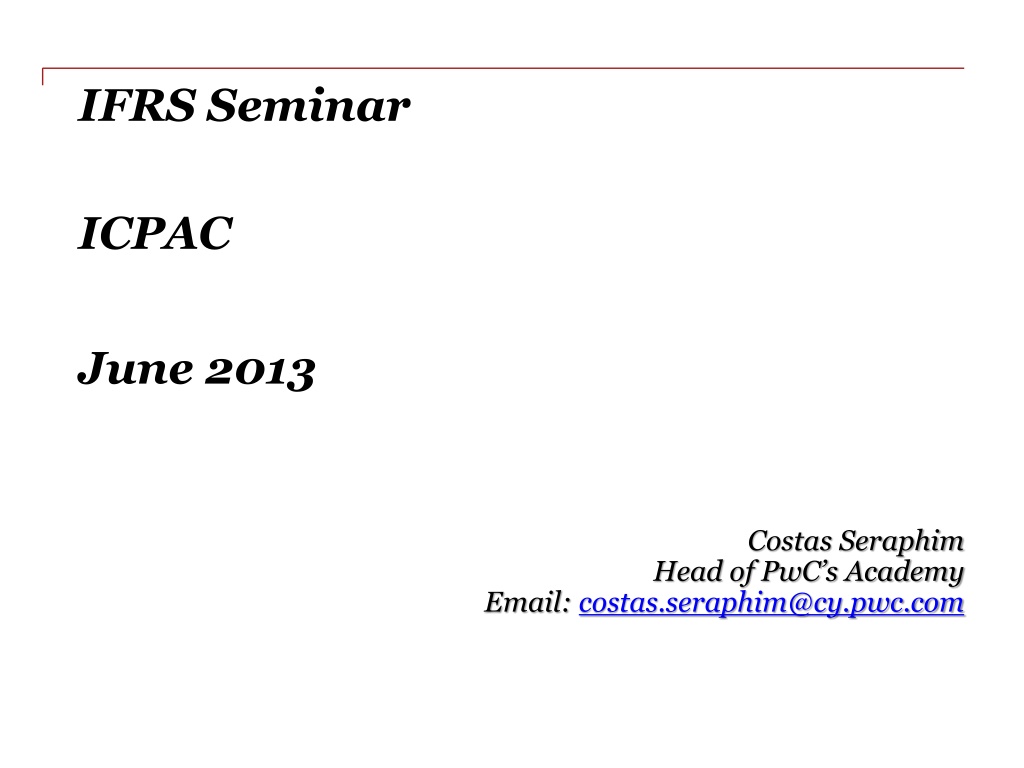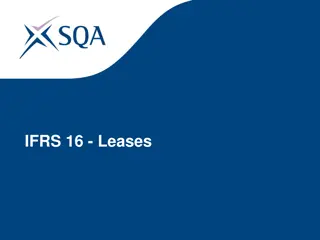Understanding Financial Instruments in IFRS: Key Concepts and Overview
This content provides an overview of financial instruments under IFRS, focusing on their classification as assets, liabilities, or equity. It explains the presentation of compound financial instruments and outlines key concepts related to financial assets, financial liabilities, and equity instruments. The content also touches upon derivatives and their characteristics under IAS 39.
Download Presentation

Please find below an Image/Link to download the presentation.
The content on the website is provided AS IS for your information and personal use only. It may not be sold, licensed, or shared on other websites without obtaining consent from the author. Download presentation by click this link. If you encounter any issues during the download, it is possible that the publisher has removed the file from their server.
E N D
Presentation Transcript
IFRS Seminar ICPAC June 2013 Costas Seraphim Head of PwC s Academy Email: costas.seraphim@cy.pwc.com
IFRS Seminar IAS 32 Financial Instruments: Presentation
Overview of session Financial instruments should be presented as assets, liabilities or equity in the statement of financial position. Compound financial instruments should be split between their liability and equity components. Interest, dividends, gains and losses should be presented in a manner consistent with the classification of the related financial instrument. Financial assets and financial liabilities can only be offset in limited circumstances 3
Review of key concepts A financial instrument is any contract that gives rise to a financial asset of one entity and a financial liability or equity instrument of another entity. An equity instrument is any contract that evidences a residual interest in the assets of another 4
Review of key concepts A financial asset is any asset that is cash, an equity instrument of another entity, a contract that (subject to certain conditions) will or may be settled in the entity s own equity instruments or a contractual right: To receive cash or another financial asset from another entity; or To exchange financial assets or financial liabilities with another entity under conditions that are potentially favourable to the entity. 5
Review of key concepts A financial liability is any liability that is a contract that (subject to certain conditions) will or may be settled in the entity s own equity instruments or a contractual obligation: To deliver cash or another financial asset to another entity; or To exchange financial assets or financial liabilities with another entity under conditions that are potentially unfavourable to the entity 6
Review of key concepts An equity instrument is any contract that evidences a residual interest in the assets of an entity after deducting all of its liabilities. A derivative is a financial instrument or other contract within the scope of IAS 39 with all three of the following characteristics: Its value changes in response to the change in a specified interest rate, financial instrument price, commodity price, foreign exchange rate etc. It requires no or very small initial net investment; and It is settled at a future date 7
Objectives and scope of IAS 32 To enhance the understanding of the users of the way in which financial instruments affect an entity s financial performance, financial position and cash flows. IAS 32 sets out the presentation requirements for financial instruments and their related interest or dividends, and specifies the circumstances in which they should be offset. The principles of IAS 32 are consistent with, and complement, those in IAS 39, which addresses recognition and measurement criteria. The scope of IAS 32 is that it applies to all entities and to all types of financial instruments except where another standard is more specific. Examples of areas which are outside the scope of IAS 32 are: Subsidiaries accounted for under IAS 27 Associates accounted for under IAS 28 Joint ventures accounted for under IAS 31. 8
Example: Investments in subsidiaries Pafos plc acquired 40,000 (80%) o the ordinary share capital of Sotera Ltd. Whilst these ordinary shares are a financial asset of Pafos, IAS 32 (and IAS 39) does not apply; the provisions of IAS 27 Consolidated and Separate Financial Statements should be applied. In the separate (company only) financial statements of Pafos plc, IAS 27 allows a choice of accounting treatment. The investment may be accounted for either at cost or in accordance with IAS 39 (as a financial asset). In practice most companies account for investments in subsidiaries, associates and jointly controlled entities at cost in their separate financial statements. Therefore, the provisions of IAS 32 (and IAS 39) are generally only applied to minor investments where the investor does not have control, significant influence or joint control. 9
Presentation of equity and liabilities When an entity issues a financial instrument, it should classify it according to the substance of the contract under which it has been issued. It should be classified as: A financial asset; or A financial liability; or An equity instrument. The characteristics of the financial instrument should be considered to ensure that it is appropriately classified. The classification should be made at the time the financial instrument is issued and not changed subsequently. The classification is important as it changes the perceived risk of the entity. The classification of an instrument as a financial liability will potentially have an adverse effect on the gearing ratio of a company and may reduce its ability to obtain further debt funding 10
Example: Equity and liabilities Redeemable Preference shares provide the holder with the right to receive an annual dividend (usually of a predetermined and unchanging amount) out of the profits of a company, together with a fixed amount on redemption. The legal form of the instrument is equity. In substance the fixed level of dividend is interest and the redemption amount is a repayment of a loan. Because financial reporting focuses on the substance of the transactions, redeemable preference shares should be presented as liabilities. In practical terms, only irredeemable preference shares are included in equity. They are less common than redeemable preference shares. 11
Compound financial instruments A compound or hybrid financial instrument is one that contains both a liability component and an equity component. As an example, an issuer of a convertible bond has: 1. The obligation to pay annual interest and eventually repay the capital the liability component. 2. The possibility of issuing equity, should bondholders choose the conversion option the equity component. In substance the issue of such a bond is the same as issuing separately a non-convertible bond and an option to purchase shares. 12
Compound financial instruments At the date of issue the components of such instruments should be classified separately according to their substance. This is often called split accounting. The amount received on the issue (net of any issue expense) should be allocated between the separate components as follows: i. The fair value of the liability component should be measured at the present value of the periodic interest payments and the eventual capital repayment assuming the bond is redeemed. ii. The present value should be discounted at the market rate for an instrument of comparable credit status and the same cash flows but without the conversion option iii.The fair value of the equity component should be measured as the remainder of the net proceeds 13
Exercise : Compound financial instruments On 1 January 20X7 an entity issued 10,000 6% convertible bonds at a par value of 100. Each bond is redeemable at par or convertible into four shares on 31 December 20X8. Interest is payable annually in arrears. The market rate of interest for similar debt without the conversion option is 8%. Requirement: Measure the liability and equity components of these bonds on 1 January 20X7. 14
Exercise : Compound financial instruments Solution: Cash flow Discount factor Present value 20X7 60,000 1/1.08 55,556 20X8 1,060,000 1/1.08(2) 908,779 Total liability component 964,335 Total proceeds 10,000 x 100 1,000,000 Equity element 35,665 15
Exercise : Compound financial instruments Solution: The subsequent accounting for the liability component should be as follows: Opening Interest Interest paid Closing balance expense (8%) balance 20X7 964,335 77,147 (60,000) 981,482 20X8 981,482 78,518 (60,000) 1,000,000 If on 31 December 20X8 all the bond holders elect to convert into equity, then the 1 million liability should be reclassified to equity, making 1,035,665 in total. The double entry should be: DR Financial liability 1 million CR Equity 1 million 16
Exercise : Compound financial instruments Solution: If none of the bonds are converted to equity, the liability of 1 million will be extinguished by the cash repayment. However, the amount already included in equity of 35,665 should remain there. The double entry should be: DR Financial liability 1 million CR Cash 1 million 17
Exercise: Dividends Dali Ltd has declared the following dividends during the year: 1 An ordinary dividend of 4 million 2 A 3 million dividend on preference shares redeemable in 20X9. Requirement: Explain the presentation requirements for Dali Ltd s dividends in the financial statements for the year 18
Exercise: Dividends Solution: Dividends payable should be classified according to the underlying financial instrument: Dividends payable on ordinary shares (an equity instrument) should be charged directly against equity. Dali Ltd s 4 million ordinary dividend should be recognised in the statement of changes in equity. Dividends payable on redeemable preference shares (a financial liability) should be recognised as an expense in profit or loss. Dali Ltd s 3 million preference dividend should be recognised in profit or loss. The dividend may be presented as part of the finance cost or as a separate line item. 19
Issue costs and Offsetting 1. When equity shares are issued, the transaction costs should be deducted from equity, net of any related income tax benefit. The transaction costs to be deducted are only those incremental costs attributable to the equity transaction that otherwise would have been avoided. 2. Financial assets and financial liabilities should generally be presented as separate items in the statement of financial position. However, offset is required if: The entity has a legal right of offset, and The entity intends to settle on a net basis. 20
Exercise: Issue costs An entity issued 100,000 new 1 ordinary shares which have a fair value of 2.50 per share for cash. Professional fees in respect of the share issue were 50,000 and are deductible for tax purposes. The tax rate is 40%. The management of the entity estimates that costs incurred internally for time incurred working on the share issue are 25,000. Requirement: How should these transactions be recorded in the financial statements? 21
Exercise: Issue costs Solution: The internal costs should be recognised as an expense in profit or loss as they were not incremental costs; they would have been incurred in any event. The professional fees were directly attributable to the transaction and 30,000 should be deducted from equity ( 50,000 net of 40% tax). The double entry to record this transaction should be: DR Cash ( 250,000 less 50,000) 200,000 DR Tax liability ( 50,000 x 40%) 20,000 CR Share capital 100,000 CR Share premium ((100,000 x( 2.50 less 1.00)) less 50,000 x60%) 120,000 22
Exercise: Offsetting Hirokitia plc and Inia Ltd trade with each other. Hirokitia plc has recognised in its financial statements trade receivables of 40,000 and trade payables of 20,000 in respect of Inia Ltd. Hirokitia plc and Inia Ltd have an informal arrangement to periodically offset balances and settle on a net basis. Solution: Hirokitia plc should not offset the trade receivables and trade payables as no legal right of offset exists. Whilst its custom and practice is to settle on a net basis, no formal right of setoff exists. 23
Treasury shares It is becoming increasingly popular for companies to reacquire their own shares as an alternative to making dividend distributions and/or as a way to return excess capital to shareholders. Equity instruments reacquired by the entity which issued them are known as treasury shares. The treatment of these treasury shares is that: They should be deducted from equity No gain or loss should be recognised in profit or loss on their purchase, sale, issue or cancellation Consideration paid or received should be recognised directly in equity The amount of treasury shares held should be disclosed either in the statement of financial position or in the notes to the financial statements in accordance with IAS 1 Presentation of Financial Statements. 24
Exercise:Treasury shares An entity entered into a share buyback scheme. It reacquired 10,000 1 ordinary shares for 2 cash per share. The shares had originally been issued for 1.20 per share. Solution: The entity should record the reacquired shares as a debit entry of 20,000 in equity. The original share capital and share premium amounts of 10,000 and 2,000 remain unchanged. 25
Amortised cost and effective interest method Example: An entity acquired a 6% 1,000 par value financial asset for its fair value of 970 at the beginning of Year 1. Interest of 6% was receivable annually in arrears. The financial asset was redeemable at the end of Year 3 at 1,030, a premium of 3% to par value. The financial asset is quoted in an active market and was classified as held to maturity by the entity. Held-to-maturity financial assets should be measured at amortised cost. The effective interest rate of the financial instrument can be calculated at 8.1%. The rate is higher than the coupon rate, because it amortises the discount on issue and the premium on redemption. The amortised cost carrying amount should be determined as follows. 26
Amortised cost and effective interest method Example: Year Opening Interest @ 8.1% Cash flow Closing balance balance in profit or loss 1 970 78 (60) 988 2 988 80 (60) 1,008 3 1,008 82 (1,090) 0 27
Thank you! 28























